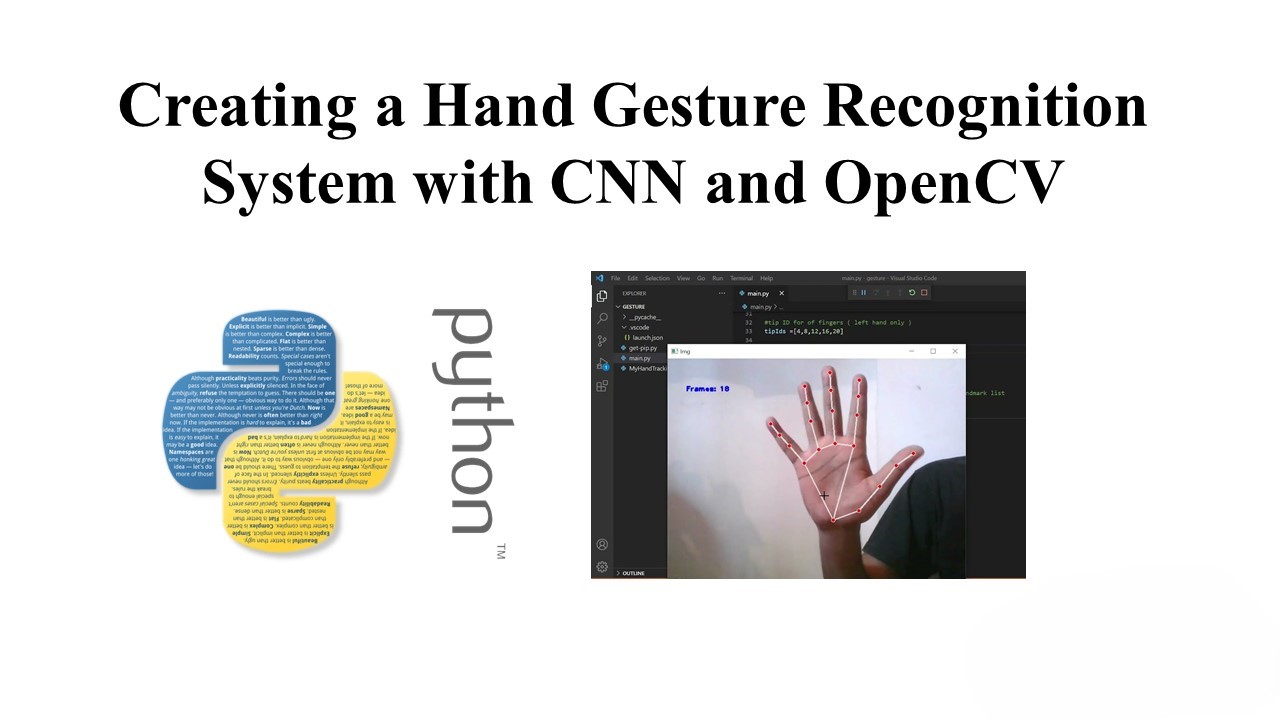Welcome back to the second part of our Hand Gesture Recognition project. In this segment, we will integrate the trained Convolutional Neural Network (CNN) with the OpenCV library to create a real-time hand gesture recognition system. Let’s dive in!
Setting Up the Environment
Before we begin, ensure you have the required libraries installed. You can use the following commands to install them:
pip install opencv-python
pip install tensorflow
pip install matplotlib
Initializing the Environment
Let’s start by initializing our environment and setting up the necessary components. This includes importing the required libraries, setting up the video capture, and defining initial parameters.
# Import necessary libraries
import cv2
import sys
import numpy as np
from tensorflow.keras.models import load_model
# Load the pre-trained hand gesture recognition model
hand_model = load_model("hand_model_gray.hdf5", compile=False)
# Define classes for gesture labels
classes = {0: 'fist', 1: 'five', 2: 'point', 3: 'swing'}
# Set up video capture
video = cv2.VideoCapture(0)
# Check if the video capture is successful
if not video.isOpened():
print("Could not open video")
sys.exit()
# Read the first frame from the video
ok, frame = video.read()
if not ok:
print("Cannot read video")
sys.exit()
# Use the first frame as the initial background frame
bg = frame.copy()
# Define a kernel for erosion and dilation of masks
kernel = np.ones((3, 3), np.uint8)
# Define display positions (pixel coordinates)
positions = {'hand_pose': (15, 40), 'fps': (15, 20), 'null_pos': (200, 200)}
# Tracking parameters
bbox_initial = (116, 116, 170, 170) # Starting position for bounding box
bbox = bbox_initial
tracking = -1
Real-Time Video Processing
Now, let’s enter the main loop where we capture, process, and display the video frames in real-time. We’ll perform background subtraction, hand tracking, and hand gesture recognition.
while True:
# Read a new frame from the video
ok, frame = video.read()
display = frame.copy()
data_display = np.zeros_like(display, dtype=np.uint8) # Black screen to display data
if not ok:
break
# Start timer
timer = cv2.getTickCount()
# Processing
# Background subtraction
diff = cv2.absdiff(bg, frame)
mask = cv2.cvtColor(diff, cv2.COLOR_BGR2GRAY)
th, thresh = cv2.threshold(mask, 10, 255, cv2.THRESH_BINARY)
opening = cv2.morphologyEx(thresh, cv2.MORPH_OPEN, kernel)
closing = cv2.morphologyEx(opening, cv2.MORPH_CLOSE, kernel)
img_dilation = cv2.dilate(closing, kernel, iterations=2)
imask = img_dilation > 0
foreground = mask_array(frame, imask)
foreground_display = foreground.copy()
# Hand tracking
if tracking != -1:
tracking, bbox = tracker.update(foreground)
tracking = int(tracking)
# Hand gesture recognition
hand_crop = img_dilation[int(bbox[1]):int(bbox[1] + bbox[3]), int(bbox[0]):int(bbox[0] + bbox[2])]
try:
# Resize cropped hand and make prediction on gesture
hand_crop_resized = np.expand_dims(cv2.resize(hand_crop, (54, 54)), axis=0).reshape((1, 54, 54, 1))
prediction = hand_model.predict(hand_crop_resized)
predi = prediction[0].argmax()
gesture = classes[predi]
# Display prediction results
for i, pred in enumerate(prediction[0]):
barx = positions['hand_pose'][0]
bary = 60 + i * 60
bar_length = int(400 * pred) + barx
colour = (0, 255, 0) if i == predi else (0, 0, 255)
cv2.putText(data_display, "{}: {}".format(classes[i], pred), (positions['hand_pose'][0], 30 + i * 60),
cv2.FONT_HERSHEY_SIMPLEX, 0.75, (255, 255, 255), 2)
cv2.rectangle(data_display, (barx, bary), (bar_length, bary - 20), colour, -1, 1)
cv2.putText(display, "hand pose: {}".format(gesture), positions['hand_pose'], cv2.FONT_HERSHEY_SIMPLEX, 0.75,
(0, 0, 255), 2)
cv2.putText(foreground_display, "hand pose: {}".format(gesture), positions['hand_pose'],
cv2.FONT_HERSHEY_SIMPLEX, 0.75, (0, 0, 255), 2)
except Exception as ex:
cv2.putText(display, "hand pose: error", positions['hand_pose'], cv2.FONT_HERSHEY_SIMPLEX, 0.75, (0, 0, 255),
2)
cv2.putText(foreground_display, "hand pose: error", positions['hand_pose'], cv2.FONT_HERSHEY_SIMPLEX, 0.75,
(0, 0, 255), 2)
# Draw bounding box
p1 = (int(bbox[0]), int(bbox[1]))
p2 = (int(bbox[0] + bbox[2]), int(bbox[1] + bbox[3]))
cv2.rectangle(foreground_display, p1, p2, (255, 0, 0), 2, 1)
cv2.rectangle(display, p1, p2, (255, 0, 0), 2, 1)
# Move the mouse
hand_pos = ((p1[0] + p2[0]) // 2, (p1[1] + p2[1]) // 2)
mouse_change = ((p1[0] + p2[0]) // 2 - positions['null_pos'][0], positions['null_pos'][0] - (p1[1] + p2[1]) // 2)
cv2.circle(display, positions['null_pos'], 5, (0, 0, 255), -1)
cv2.circle(display, hand_pos, 5, (0, 255, 0), -1)
cv2.line(display, positions['null_pos'], hand_pos, (255, 0, 0), 5)
# Calculate Frames per second (FPS)
fps = cv2.getTickFrequency() / (cv2.getTickCount() - timer)
cv2.putText(foreground_display, "FPS : " + str(int(fps)), positions['fps'], cv2.FONT_HERSHEY_SIMPLEX, 0.65,
(50, 170, 50), 2)
cv2.putText(display, "FPS : " + str(int(fps)), positions['fps'], cv2.FONT_HERSHEY_SIMPLEX, 0.65, (50, 170, 50), 2)
# Display result
cv2.imshow("display", display)
cv2.imshow("data", data_display)
cv2.imshow("diff", diff)
cv2.imshow("thresh", thresh)
cv2.imshow("img_dilation", img_dilation)
try:
cv2.imshow("hand_crop", hand_crop)
except:
pass
cv2.imshow("foreground_display", foreground_display)
k = cv2.waitKey(1) & 0xff
if k == 27:
break # ESC pressed
elif k == 114 or k == 108:
bg = frame.copy()
bbox = bbox_initial
tracking = -1
elif k == 116:
tracker = setup_tracker(2)
tracking = tracker.init(frame, bbox)
elif k == 115:
fname = os.path.join("data", CURR_POS, "{}_{}.jpg".format(CURR_POS, get_unique_name(
os.path.join("data", CURR_POS))))
cv2.imwrite(fname, hand_crop)
elif k != 255:
print(k)
cv2.destroyAllWindows()
video.release()
Conclusion
Congratulations! You’ve now completed the implementation of a real-time hand gesture recognition system. This project combines the power of Convolutional Neural Networks for image classification with OpenCV for video processing and tracking.
Feel free to explore and enhance the system further, perhaps by adding more gestures or refining the tracking mechanism. This project opens the door to a wide range of applications, from gesture-controlled interfaces to interactive experiences.
Thank you for joining us in this two-part blog series. We hope you enjoyed building this hand gesture recognition system!


Leave a Reply